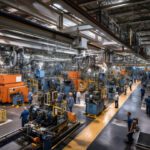Predictive Maintenance for Critical Infrastructure and Asset Protection
Let’s face it: in a world where every minute counts, the last thing anyone needs is an unexpected equipment failure, throwing a wrench in the works. This is exactly why predictive maintenance for critical infrastructure and asset protection isn’t just nice to have; it’s essential. With an average ROI of 3800%, ignoring this proactive approach could mean missing out on not only saving time but also significantly cutting down costs. But with so many moving parts (literally), where do you even start? Hang around because we’re diving into ways to ensure your operations stay on track, minus the unwelcome shocks. Let’s delve into a discussion on Predictive Maintenance for Critical Infrastructure and Asset Protection.
Understanding Predictive Maintenance for Critical Infrastructure
Predictive maintenance is a game-changer for critical infrastructure. It’s not just about fixing things when they break; it’s about predicting and preventing breakdowns before they happen.
That’s the power of predictive maintenance. And it’s all thanks to the magic of data analytics and condition monitoring techniques.
What is Predictive Maintenance?
.jpeg)
Predictive maintenance (PdM) is a proactive approach to asset management that utilizes data analysis and condition monitoring techniques to predict when maintenance interventions are necessary, optimizing maintenance strategies and reducing downtime.
Imagine having a magic globe that lets you peek into the future of your critical infrastructure. You can see into the future and know exactly when and where to focus your maintenance efforts.
Benefits of Predictive Maintenance
By tapping into predictive maintenance, you’re not just cutting down on costs; you’re also boosting how well your operations run, making sure your assets last longer, and ramping up safety to boot. Staying ahead of the game by spotting potential problems before they turn into big headaches, predictive maintenance keeps things running smoothly. It ensures your assets are always performing at their best.
It’s a win-win situation. You save money, reduce downtime, and keep your critical infrastructure running like a well-oiled machine.
Role of Data Analytics in Predictive Maintenance
Data analytics plays a crucial role in predictive maintenance by enabling the analysis of vast amounts of data collected from sensors and other sources. Machine learning algorithms and predictive models are used to identify patterns, anomalies, and trends that indicate potential failures, allowing for timely maintenance interventions.
Imagine you’ve got your squad of data sleuths tirelessly watching over your crucial infrastructure, always on the lookout for any hint of a problem.
Condition Monitoring Techniques
Condition monitoring techniques are the eyes and ears of predictive maintenance. These tools are your eyes on the ground, constantly scanning your vital infrastructure for any shifts or oddities that might signal trouble brewing.
We continue to have a number of constructive discussions with various customers on this topic and supporting them in either deploying solely wireless vibration sensors across their assets or supporting them in a hybrid strategy, in particular, to deliver predictive maintenance (PdM) outcomes.
From vibration analysis to oil analysis, there are a variety of condition monitoring techniques that can be used to gather valuable data about the health and performance of your critical assets.
Key Components of a Predictive Maintenance Program
A successful predictive maintenance program is like a well-orchestrated symphony. Every piece matters when it comes to keeping your vital systems humming along and performing at their peak.
From data collection and management to predictive modeling and machine learning, several key components make up a comprehensive predictive maintenance program.
Data Collection and Management
To nail a predictive maintenance program, you’ve got to get your hands dirty with gathering and handling data the right way. This involves deploying sensors and other data acquisition devices to gather real-time data from critical assets, as well as implementing robust data storage, integration, and governance practices to ensure data quality and accessibility.
It’s like building a solid foundation for your predictive maintenance program. Without accurate and reliable data, your predictive models and maintenance strategies will be built on shaky ground.
Predictive Modeling and Machine Learning
Predictive modeling and machine learning are the brains behind a predictive maintenance program. By leveraging advanced algorithms and techniques such as artificial neural networks, support vector machines, and deep learning, organizations can build accurate models that predict asset failures and optimize maintenance strategies.
Imagine you’ve got this team of genius robots, and they’re all about making sure the essential parts of your operation run like clockwork.
Maintenance Planning and Scheduling
With predictive maintenance, planning, and scheduling, your upkeep becomes a whole lot smarter and more streamlined. By leveraging insights from predictive models, maintenance teams can prioritize interventions based on risk and criticality, ensuring that the right maintenance activities are performed at the right time to minimize downtime and maximize asset reliability.
Imagine having a super clear guide for all your upkeep tasks, one that leads you straight to the sweet spot of top-notch asset performance and dependability.
Continuous Monitoring and Improvement
Keeping an eye on things and constantly making them better is key if you want your predictive maintenance program to go the distance. This involves ongoing data collection, analysis, and refinement of predictive models to adapt to changing conditions and ensure the program remains effective over time.
Regular performance monitoring and benchmarking help identify areas for improvement and drive continuous optimization. Think of it as having your very own loop that always brings you back on track, making sure your predictive maintenance plan gets better and sharper with every round.
Implementing Predictive Maintenance for Critical Assets

Kicking off predictive maintenance for your key assets is like starting a journey that leads you to the best possible performance and dependability of those assets. To get it right, you need a solid plan, action that hits the mark, and a promise to keep getting better at what you do.
But trust me, the payoff is absolutely worth every bit of hard work you put in. By implementing predictive maintenance, you can unlock the full potential of your critical assets, reducing downtime, minimizing maintenance costs, and maximizing operational efficiency.
Identifying Critical Assets
The first step in implementing predictive maintenance for critical assets is to identify which assets are most critical to the organization’s operations and prioritize them based on factors such as their impact on production, safety, and financial performance.
This helps focus resources on the assets that have the greatest potential to benefit from predictive maintenance. It’s like putting your money where it matters most.
Assessing Current Maintenance Practices
Before implementing predictive maintenance, it is important to assess the organization’s current maintenance practices and identify areas for improvement. This may involve conducting a gap analysis to compare current practices against best practices and industry standards, as well as evaluating the effectiveness of existing maintenance programs and technologies.
It’s akin to giving yourself a straight talk in front of the mirror, acknowledging your current position, and mapping out your path forward.
Developing a Predictive Maintenance Roadmap
Creating a plan for predictive maintenance means you have to lay out what you hope to achieve, figure out the tools and tech you’ll need, and decide on a timeline for getting everything up and running.
The roadmap should also consider factors such as organizational readiness, change management, and training needs to ensure a smooth and successful transition to predictive maintenance. It’s like creating a blueprint for success.
Measuring Success and ROI
Measuring the success and return on investment (ROI) of a predictive maintenance program is critical for demonstrating its value and justifying continued investment. This involves establishing key performance indicators (KPIs) such as overall equipment effectiveness (OEE), mean time between failures (MTBF), and maintenance cost savings, as well as regularly tracking and reporting on these metrics to stakeholders.
Think of it as tracking your progress and giving yourself a high-five for each achievement along the way. By measuring success and ROI, you can prove the value of predictive maintenance and secure ongoing support and investment in the program.
Key Takeaway:
Predictive maintenance transforms how we handle critical infrastructure by using data analytics and condition monitoring to predict issues before they happen. It’s all about staying ahead, saving costs, and keeping things running smoothly.
Overcoming Challenges in Predictive Maintenance Adoption

But let’s be real; it’s not always a walk in the park.
Getting predictive maintenance off the ground means you’ll have to maneuver through some challenging spots skillfully, from data quality issues to skill gaps, and some hurdles need to be cleared.
Data Quality and Integration
Data is the lifeblood of predictive maintenance. But getting that data in order? It’s no small feat.
Ensuring data quality and integrating data across different systems can be a major headache. It requires solid data governance practices, rigorous quality checks, and some serious data wrangling to create a unified view of asset performance.
Skill Gap and Training
Predictive maintenance isn’t just about fancy algorithms. It takes people with the right skills to make it work.
Organizations often face a shortage of talent in areas like data science and advanced analytics. Bridging that skill gap means investing in training programs to level up existing staff or bringing in fresh faces with the necessary expertise.
Organizational Change Management
Predictive maintenance isn’t just a technical shift. It’s a cultural one, too.
Shifting gears from reacting to issues as they pop up to stopping problems before they even start means we’ve got to tweak our processes, rethink our roles, and adjust how we see things. Effective change management is key to getting everyone on board and making predictive maintenance stick for the long haul.
Vendor Selection and Partnerships
Choosing the right predictive maintenance vendor is critical. But with so many options out there, it can be tough to know where to start.
When picking vendors, it pays to go with those who know their stuff inside and out, have a solid history of success, and offer solutions that are just the right fit for what you need. Building strong partnerships with vendors can give you access to cutting-edge tech and best practices, plus ongoing support to keep your predictive maintenance program humming.
Future Trends in Predictive Maintenance and Asset Protection

Predictive maintenance is evolving at warp speed. As AI and other advanced technologies mature, the possibilities are endless.
Here’s a glimpse into the future of predictive maintenance and asset protection:
Advancements in AI and Machine Learning
AI and machine learning are the rocket fuel propelling predictive maintenance forward. Techniques like deep learning, reinforcement learning, and transfer learning are enabling smarter, more adaptive predictive models that get better with age.
Edge Computing and Real-time Analytics
Edge computing and real-time analytics are the dynamic duo of predictive maintenance. By processing sensor data closer to the source, edge computing enables lightning-fast insights and reduced data transmission costs.
Real-time analytics takes it to the next level, serving up actionable intel right when you need it. Imagine you’ve got a magic orb that lets you peek into the future of your investments.
Integration with Other Maintenance Strategies
Predictive maintenance isn’t a solo act. It plays well with other maintenance strategies like preventive and reactive maintenance.
The future of predictive maintenance is all about integration. By combining the strengths of different approaches, organizations can optimize their maintenance programs and drive better results.
Predictive Maintenance as a Service
Predictive maintenance as a service (PaaS) is the new kid on the block. It’s like having predictive maintenance on tap without all the upfront costs and hassle.
With PMaaS, you can tap into the latest predictive maintenance tech and expertise on a subscription basis. It’s a great way to get started with predictive maintenance without breaking the bank or getting bogged down in the details.
Key Takeaway:
Predictive maintenance transforms asset care but comes with hurdles like data quality, skill gaps, and the need for organizational change. It demands solid data handling, ongoing training, strategic vendor partnerships, and embracing new tech like AI. Staying ahead means integrating it seamlessly with other strategies and possibly opting for Predictive Maintenance as a Service (PaaS) to ease adoption.
Frequently Asked Questions
What is predictive maintenance?
Predictive maintenance is a strategy that utilizes data analytics, artificial intelligence, and machine learning to monitor the operating conditions and performance of physical assets (equipment, machinery, etc.). Analyzing this data can predict potential issues or failures before they occur, allowing for proactive maintenance work to be scheduled to prevent breakdowns and extend the lifespan of the assets.
What are the key benefits of predictive maintenance?
Some key benefits include reduced maintenance costs by avoiding unnecessary preventive maintenance, increased equipment uptime and availability, optimized spare parts inventory and supply chain, improved safety by mitigating risks of equipment failure, and extended useful life of physical assets.
How does predictive maintenance differ from preventive maintenance?
Preventive maintenance follows a fixed schedule based on usage or time intervals for maintenance tasks. Predictive maintenance, on the other hand, is condition-based – it monitors asset data and indicators to precisely determine when maintenance should be performed based on the actual state of equipment rather than adhering to predetermined schedules.
What kind of data is used for predictive maintenance?
A variety of data points can be leveraged, such as equipment sensor data, operational data logs, inspection data, environmental data, and even inputs from cameras or audio sensors. This diverse data is synthesized using techniques like machine learning to build predictive models.
How can businesses implement predictive maintenance strategies?
Implementing predictive maintenance typically involves deploying IoT sensors on critical assets, building data pipelines to collect and manage asset data, utilizing cloud-based analytics platforms that offer predictive maintenance services based on AI/ML models, and establishing processes to act on predictions for maintenance planning and execution.
Conclusion
In wrapping up our journey through the ins and outs of predictive maintenance for critical infrastructure and asset protection, let’s take stock of what we’ve learned. It turns out that Hollywood got it wrong – AI isn’t here to usher us into dystopia; rather, its role lies quietly behind the scenes, enhancing our lives by making daily tasks simpler and keeping our physical assets humming along nicely through proactive maintenance strategies. Much like smart assistants make life easier without much fanfare, implementing a robust predictive maintenance strategy serves silently yet powerfully – preventing costly downtime, addressing potential issues before they occur, and extending the lifespan of vital equipment.
The key benefits? Embracing this forward-thinking approach doesn’t just prevent headaches (and heartaches) from sudden equipment failures due to unoptimized operating conditions; it fundamentally shifts how we interact with technology – from reactive bystanders to proactive guardians of our mechanical cohorts through predictive maintenance offers that proactively identify maintenance work needed based on data management and artificial intelligence. As businesses continue marching towards automation and smarter supply chain and systems integration, staying ahead means tuning into these silent background processes that might be the unsung heroes in safeguarding operational continuity and reducing costs associated with unplanned stoppages.
Predictive maintenance work allows us to predict maintenance needs, thereby extending asset life and preventing potential disasters. By addressing issues before they occur, predictive maintenance strategies empower us to maintain an edge in an ever-competitive market landscape.









